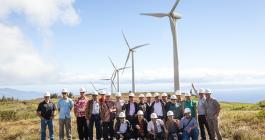It is estimated that around 840 million people around the world lack access to electricity, and many more lack reliable access. Since reliable electricity access is critical for economic growth and education, increasing generation capacity is a critical development goal. Electricity can be generated from a variety of energy resources such as:
Traditional
- Natural Gas
- Hydropower
- Biomass
- Oil
- Coal
Alternative
- Wind
- Solar
- Geothermal
The Energy Utility Partnership Program (EUPP) is working with our partner countries to increase their ability to develop new generation capacity and maintain the efficient operation of their existing generation units in order to achieve a reliable and sufficient production of electricity. Our work promotes national energy security by diversifying the energy mix of our partner counties through projects such as; integrating renewable generation into existing generation systems; developing generation systems that can adapt over time to incorporate new technologies and fuels; implementing asset management best practices; establishing reverse energy auctions, wholesale markets and power purchase agreements that lower costs and improve generation availability; and more.
--
Energy Mix Diversification
--
Flexible Operations
A significant factor in the successful operation of a modern generation fleet is its ability to adapt to the challenges brought on by new technologies, markets and operating practices. The integration of renewable and distributed energy resources (DER) and the trading of energy in wholesale markets will change the way a generation system has to be operated. Utilities must maintain flexibility in their generation operating practices and policies. EUPP is working with utilities around the world to help them adapt their policies, strategies and operational practices so they can successfully cope with these new challenges.
--
Integrating Independent Power Producers (IPPs)
Independent Power Producers (IPPs) are non-utility energy companies that generate power and sell it to utilities and other end users through negotiated power purchase agreements. If IPP’s are to be successfully integrated into the generation sector they must be allowed reasonable tariffs, fair and transparent access to energy markets, and there has to be mechanisms in place to prevent incumbent utilities from having undue influence on the operation of an open and competitive marketplace.
--
Power Purchase Agreements (PPAs)
A power purchase agreement (PPA), or electricity power agreement, is a contract between two parties, one which generates electricity and one which is purchasing electricity. PPAs are generally long-term contracts with agreed upon pricing and capacity delivery that reduces future market risks. EUPP provides our partner countries with the skills needed to negotiate and implement PPA’s.
--
Natural
Natural gas is the cleanest and fastest growing fossil fuel, contributing almost one-third of total global energy demand growth in the last decade, more than any other fuel. It is one of the safest and most useful energy sources. Natural gas-fired generation
--
Asset Management
Organizations use Asset Management Programs (AMP) to
--
Hydropower Plant Maintenance and Dam Safety
Hydropower is the world’s largest source of renewable energy generation. It has become more important as its inherent ability to rapidly raise or lower its output power offsets the variability of output associated with the integration of intermittent renewable power systems. The full benefits of hydropower can only be realized when the operation and maintenance of hydropower facilities is systematically administered. EUPP works with partner utilities to improve their in-house capacity for performing operating, maintenance and safety procedures at hydropower plants.
--
Geothermal
Geothermal energy is a renewable energy source that uses heat from deep inside the earth to generate steam to make electricity. Geothermal energy provides a clean, reliable, baseload source of power with an estimated 15,000 MW of potential geothermal capacity in East Africa. The capture of this abundant geothermal energy source is critical to East Africa’s economic development. EUPP works in East African countries to promote the development of geothermal energy projects under the U.S.-East Africa Geothermal Partnership (EAGP).
--
Energy Storage Systems
Renewable generation sources, such as wind and solar, are cost effective solutions for adding new generation sources to meet growing energy demands. However, the variability of their output creates system operation issues that decrease their overall availability which can be greatly improved by the addition of energy storage devices that put energy onto the grid at times when the output from renewable sources are lacking.
Energy storage systems (ESS) are increasingly playing an important role in grid balancing, creating a more flexible and reliable grid system. The most commonly known ESS are battery energy storage systems (BESS) and pumped hydro storage.






